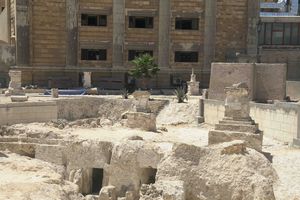THE TOMBS
HYPOGEUM A (1)
This impressive underground multichambered complex is articulated around a subterranean aule (open-air court), with rock-cut burial chambers to its west, north and east sides. During the 2020-22 archaeological investigation, the remnants of the south wall of the aule were revealed, possibly representing the original elaborated facade of the complex. Hypogeum A bears impressive architectural decoration, recalling those of the monumental tombs of Macedon. The walls of the aule are decorated with Doric semi-columns, forming a pseudoperistyle. False-windows are traceable in the intercolumniation.
East Burial Unit, inc. Klinai Chamber (a)
This unit consists of two chambers. The first hosts 4 loculi in each long side, arranged between Ionic semi-columns. The Ionic doorframes of the loculi were originally sealed with slabs. The back wall of the chamber has a temple-like façade, with a triangular pediment, supported by four Ionic semi-columns. It provides access to the second chamber, which is occupied by two rock-cut sarcophagi in the form of symposium klinai (banqueting benches), an indication of Greek-elite lifestyle. Traits of painted decoration are still visible on the walls.
West Burial Unit (b)
A small burial chamber with 8 loculi is situated to the west side of the court. Loculi were originally sealed with slabs bearing painted decoration.
North Section (c)
Behind the north wall of the aule, there is a vestibule, the walls of which are decorated in relief with semi-opened false-windows. In the west side of the vestibule, there is a burial chamber with 17 loculi. Some of them were found sealed with slabs bearing painted or relief imitations of doorways. Above the frame of a loculus of the north side, one can still read: ΦΙΛΟΤΕΚΝΕ ΧΑΙΡΕ (farewell Philoteknos). In the east side of the vestibule, there is a stone bench and two loculi, once used as ossuaries. A gate to the north wall of the vestibule leads to another corridor with a 12-loculi burial chamber to its east side and a room for practical purposes to its west.
HYPOGEA B AND C (2 and 3)
To the west of Hypogeum A, the ruins of two minor burial complexes were discovered, Hypogea B and C.
ABOVE-GROUND MONUMENTS (4)
The towers, some of which still stand in the site, were once topped with grave stelai or altars marking burials of individuals in rock-cut pits, beneath them.










